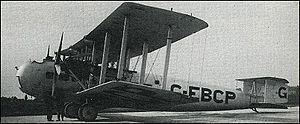Top speed 180 km/h Length 16 m | Wingspan 27 m First flight 1923 | |
 | ||
The Vickers Vanguard was a 1920s British airliner developed by Vickers Limited from the Victoria.
Contents
Design and development
Developed from the earlier Victoria with the introduction of a wider fuselage, the Vanguard was a 22-passenger twin-engined biplane. Originally built for the Air Ministry as the Type 62 the aircraft powered by two 450 hp Napier Lion engines first flew on 18 July 1923. It was re-engined in 1925 with two 650 hp Rolls-Royce Condor IIIs and re-designated the Type 103. When it was handed over to Imperial Airways in 1925 it was described as the World's largest passenger aeroplane.
The aircraft was re-conditioned in 1928 and re-designated the Type 170 for use by Imperial Airways for route proving trials, starting in May 1928. Ii operated on the London-Paris route, typically taking about 2½ hrs, and then on the London Brussels-Cologne service. It set a world load carrying record on 6 July 1928. The aircraft was withdrawn from its airline duties in October 1928 for modifications, probably to the tail, but crashed at Shepperton, Middlesex on 16 May 1929 at the start of flying trials, killing the pilot Tiny Scholefield and the flight observer Frank Sharrett..
Variants
Specifications (Type 170)
Data from
General characteristics
Performance
